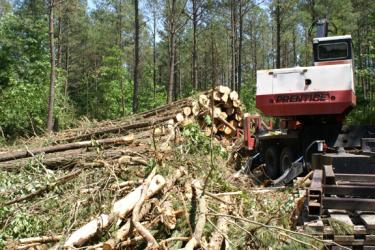Best Practices for Your Timber Sale
Most woodland owners are a little anxious during a timber harvest, and rightfully so. The process is complicated and things can go wrong. So give your timber sale due time and attention and keep these best practices in mind.
- Carefully select the trees that should be harvested. Once you’ve selected them, mark them in multiple places. After the harvest, make sure to check that only marked trees were cut. This is important for ensuring that the loggers do not cut or damage any trees that are not yet ready for harvesting or should be preserved for aesthetic or forest health reasons.
- Don’t take the first offer that comes along. Whether it’s a fair offer or not, you’re better served by taking the time to determine the value of your trees, develop the best plan for your land and locate several interested buyers.
- Don't take a potential buyer's assessment of your timber at face value. If a potential buyer tells you that your trees are dying, damaged or otherwise of low quality, and offers you a low bid, remember that you have no reason to trust them. Your forester, who works only for your interests, will give you a more accurate sense of your timber’s value.
- When selling standing trees, consider both the bidders’ prices and logging practices when choosing the winning bid. Factor both when choosing the best bid. Make sure you discuss all your concerns and expectations about the harvest with the buyer before signing a contract or proceeding with the sale.
- Ask potential buyers or loggers for references before making your choice. Talk to a few woodland owners whose timber they recently harvested. If the owner will allow you, visit at least one property the buyer has harvested and look for signs of damaged or scraped trees, rutted soil or trash on the site.
- Ask your buyer for a down payment when the deal is struck (usually around 25 percent, depending on your payment method), and complete payment before the harvest begins. Remember, if you've sold your timber as stumpage, the buyer and his/her loggers assume all the financial risk in case the timber is not as valuable as they estimated.
- Find out your local environmental regulations and legal responsibilities before harvesting. And make sure your logger is informed about these and able and willing to implement them. Also make sure the logger carries workers’ compensation insurance and adequate liability insurance. This will protect you if anyone is injured on your property.
- Let neighbors and adjacent landowners know that a harvest will be taking place, so they’re not caught by surprise. Use good judgment if checking on the harvest yourself. You don’t want to endanger yourself or anyone else by getting too close to the action. If you notice any questionable activities, deal directly with your buyer’s representative.
- Don’t wait until after your harvest to start planning for the future of your forest. Start thinking about and preparing for planting new trees or encouraging new growth early on, and your woods will thank you for it.
As you implement these best practices, remember that a knowledgeable, compassionate consulting forester can be a great help and support at every step. The right consulting forester can help you develop the ideal harvest plan for your woods and your goals, assist you with the sale and even supervise the harvest itself—everything you need to make the process pain-free. You can often pay the forester with a small share of the sale proceeds. Considering that foresters are often able to get landowners substantially more money for their timber, the forester's services might cost you nothing at all.
Find out more
- Tips on How to Get the Most from Your Timber Harvest: This fact sheet from the Purdue University Department of Forestry and Natural Resources has good information on the financial aspects of timber sales, including different selling and bidding processes and the basics of how to appraise your timber.
- Top Ten Things Not to Do When Selling Timber: Also check out this fact sheet from the Iowa Department for Natural Resources to avoid some common mistakes.
How can I get more tips?
It’s simple! Enter your email below.

